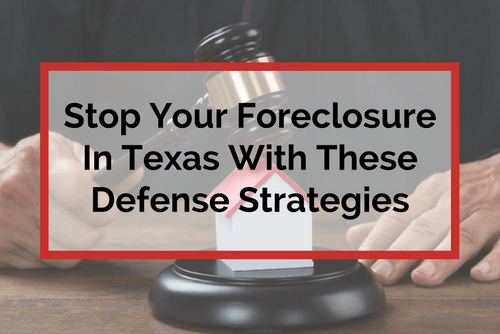In Texas, one out of every 2,522 homes faces foreclosure.
In some counties, this number tightens even more. According to RealtyTrac, a vast majority of these homes go up for auction, while a small majority will be bank-owned sales. Sadly, foreclosure filings are still up for 2016, with auctions increasing by 4.4 percent from 2015.
While the total number of foreclosures have fallen, homeowners facing a foreclosure in Texas need to take action immediately.
The Impact Of A Foreclosure
A foreclosure is when the real property a borrower currently holds is sold to satisfy an outstanding loan.
The bank holds the loan and when the loan is not paid, the borrower loses their rights to the property and the home is sold to satisfy the outstanding debt.
It is important to note, however, that outstanding balances post-sale could still be a liability for the borrower. Meaning, even if the borrower loses their home to foreclosure, they may have to pay the remaining balance after the home has been sold (depending on the loan amount being collected).
Understanding The Process For a Foreclosure In Texas
Under Texas Property Code Section 51.002 through 51.003, the lender can engage in a nonjudicial foreclosure, which means the foreclosure happens outside of the court.
When following the procedure for a nonjudicial foreclosure, the lender must follow specific steps, which include:
- Notice of Default: The foreclosing party must give the owner two notices; one is the notice of default. The mortgage servicer sends the notice of default. They must send the Notice of Default and Intent to Accelerate, which gives the homeowner 20 days to rectify the situation.
- Notice of Sale: After the 20 days have expired, and at a minimum of 21 days before the foreclosure sale, the mortgage servicer must then mail the Notice of Sale to the borrower. This must also be posted at the courthouse door and filed with the county clerk’s office.
A borrower does have up to 20 days to reinstate the loan after they have been served with the Notice of Default. However, there is no right of redemption in the state of Texas.
Why Lenders Foreclose
A lender cannot foreclose on a property without following the state’s rules.
Each month, a borrower has a set due date for their mortgage payment. If the payment is not received by the respective due date, the lender considers it a delinquency. A late fee is typically assessed after the 15-day cutoff period. At the 16th day, the first notice may be sent to the borrower.
A loan is at default status when it is 30 days past due, according to the Texas Department of Housing and Community Affairs. It is not until the loan is 60 days past due that the lender can refuse to accept partial payments and may require the balance due paid in full before they start the foreclosure process.
In most cases, the foreclosure process does not start until the 90-day past due mark.
How Hiring A Bankruptcy Attorney Can Help
An Arlington foreclosure attorney may be able to help a borrower save their home, especially if they are not too deep into the foreclosure process.
Once bankruptcy is filed, a stay of execution is applied and the mortgage company has to put the foreclosure process on hold.
Those facing foreclosure must speak with an attorney that has extensive knowledge in the area of bankruptcy law.
If you are facing a foreclosure in Texas, please contact the Law Offices of David S Kohm & Assoiates at one of our convenient locations.













